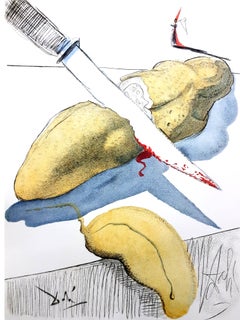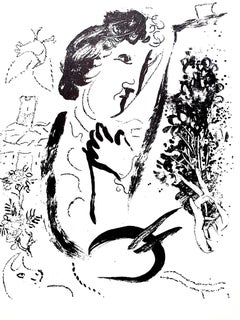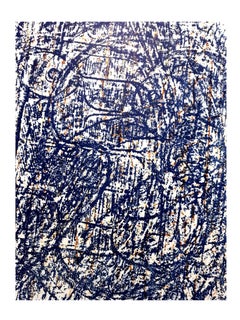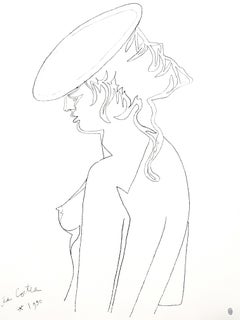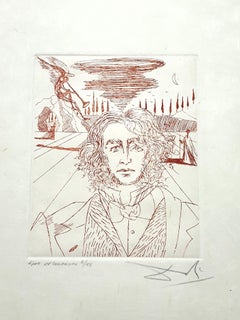Surrealist Figurative Prints
In the wake of World War I’s ravaging of Europe, artists delved into the unconscious mind to confront and grapple with this reality. Poet and critic André Breton, a leader of the Surrealist movement who authored the 1924 Surrealist Manifesto, called this approach “a violent reaction against the impoverishment and sterility of thought processes that resulted from centuries of rationalism.” Surrealist art emerged in the 1920s with dreamlike and uncanny imagery guided by a variety of techniques such as automatic drawing, which can be likened to a stream of consciousness, to channel psychological experiences.
Although Surrealism was a groundbreaking approach for European art, its practitioners were inspired by Indigenous art and ancient mysticism for reenvisioning how sculptures, paintings, prints, performance art and more could respond to the unsettled world around them.
Surrealist artists were also informed by the Dada movement, which originated in 1916 Zurich and embraced absurdity over the logic that had propelled modernity into violence. Some of the Surrealists had witnessed this firsthand, such as Max Ernst, who served in the trenches during World War I, and Salvador Dalí, whose otherworldly paintings and other work responded to the dawning civil war in Spain.
Other key artists associated with the revolutionary art and literary movement included Man Ray, Joan Miró, René Magritte, Yves Tanguy, Frida Kahlo and Meret Oppenheim, all of whom had a distinct perspective on reimagining reality and freeing the unconscious mind from the conventions and restrictions of rational thought. Pablo Picasso showed some of his works in “La Peinture Surréaliste” — the first collective exhibition of Surrealist painting — which opened at Paris’s Galerie Pierre in November of 1925. (Although Magritte is best known as one of the visual Surrealist movement’s most talented practitioners, his famous 1943 painting, The Fifth Season, can be interpreted as a formal break from Surrealism.)
The outbreak of World War II led many in the movement to flee Europe for the Americas, further spreading Surrealism abroad. Generations of modern and contemporary artists were subsequently influenced by the richly symbolic and unearthly imagery of Surrealism, from Joseph Cornell to Arshile Gorky.
Find a collection of original Surrealist paintings, sculptures, prints and multiples and more art on 1stDibs.
1960s Surrealist Figurative Prints
Etching
1960s Surrealist Figurative Prints
Etching
1960s Surrealist Figurative Prints
Lithograph
1960s Surrealist Figurative Prints
Lithograph
1950s Surrealist Figurative Prints
Lithograph
1960s Surrealist Figurative Prints
Etching
1970s Surrealist Figurative Prints
Etching
21st Century and Contemporary Surrealist Figurative Prints
Archival Ink, Rag Paper, Giclée
20th Century Surrealist Figurative Prints
Etching, Aquatint
21st Century and Contemporary Surrealist Figurative Prints
Rag Paper, Giclée, Archival Ink
21st Century and Contemporary Surrealist Figurative Prints
Photographic Paper
1970s Surrealist Figurative Prints
Drypoint, Aquatint
21st Century and Contemporary Surrealist Figurative Prints
Photographic Paper
21st Century and Contemporary Surrealist Figurative Prints
Rag Paper, Giclée, Archival Ink
Early 2000s Surrealist Figurative Prints
Paper
1950s Surrealist Figurative Prints
Lithograph
1970s Surrealist Figurative Prints
Etching
21st Century and Contemporary Surrealist Figurative Prints
Photographic Paper
1970s Surrealist Figurative Prints
Etching
1970s Surrealist Figurative Prints
Etching
21st Century and Contemporary Surrealist Figurative Prints
Photographic Paper
1970s Surrealist Figurative Prints
Etching
1970s Surrealist Figurative Prints
Etching
1970s Surrealist Figurative Prints
Etching
1960s Surrealist Figurative Prints
Etching
1970s Surrealist Figurative Prints
Etching
21st Century and Contemporary Surrealist Figurative Prints
Archival Ink, Rag Paper, Giclée
1970s Surrealist Figurative Prints
Paper, Lithograph
21st Century and Contemporary Surrealist Figurative Prints
Photographic Paper
21st Century and Contemporary Surrealist Figurative Prints
Archival Ink, Rag Paper, Giclée
21st Century and Contemporary Surrealist Figurative Prints
Photographic Paper
21st Century and Contemporary Surrealist Figurative Prints
Photographic Paper
1960s Surrealist Figurative Prints
Engraving
20th Century Surrealist Figurative Prints
Paper, Cotton, Digital
21st Century and Contemporary Surrealist Figurative Prints
Photographic Paper
1970s Surrealist Figurative Prints
Paper, Engraving
1960s Surrealist Figurative Prints
Etching
1970s Surrealist Figurative Prints
Paper, Engraving
21st Century and Contemporary Surrealist Figurative Prints
Photographic Paper
21st Century and Contemporary Surrealist Figurative Prints
Photographic Paper
1970s Surrealist Figurative Prints
Lithograph
1960s Surrealist Figurative Prints
Etching
21st Century and Contemporary Surrealist Figurative Prints
Rag Paper, Archival Ink, Giclée
1960s Surrealist Figurative Prints
Engraving
1970s Surrealist Figurative Prints
Etching
1970s Surrealist Figurative Prints
Lithograph
1950s Surrealist Figurative Prints
Lithograph
21st Century and Contemporary Surrealist Figurative Prints
Photographic Paper
1960s Surrealist Figurative Prints
Etching
1980s Surrealist Figurative Prints
Screen
21st Century and Contemporary Surrealist Figurative Prints
Photographic Paper
1960s Surrealist Figurative Prints
Paper, Woodcut
1960s Surrealist Figurative Prints
Engraving
1960s Surrealist Figurative Prints
Lithograph
1960s Surrealist Figurative Prints
Lithograph
21st Century and Contemporary Surrealist Figurative Prints
Photographic Paper
1980s Surrealist Figurative Prints
Lithograph
1960s Surrealist Figurative Prints
Etching
1980s Surrealist Figurative Prints
Archival Paper, Etching, Aquatint
1960s Surrealist Figurative Prints
Etching, Aquatint

